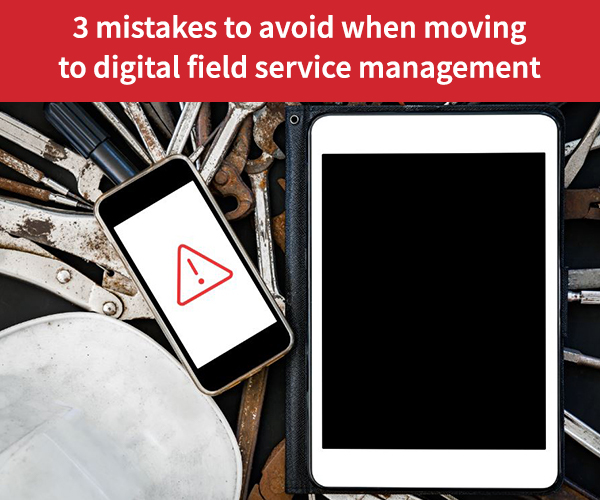
- Field Service Management
- utilities
- energy
- workforce
5 Tips for Energy and Utilities Companies to Improve Their Workforce Management

Across North America, energy and utilities companies are navigating a technician shortage. This challenge is particularly problematic for the U.S. transition to clean energy, with recruitment presenting a bottleneck for infrastructure transformation.
“While the new clean energy policies are expected to create more than 9 million jobs over the next decade, and the hiring rate and job creation in clean energy is higher than the national average, the skilled workforce is in short supply,” writes Tsvetana Paraskova for an article in Business Insider.
There’s a need for energy and utilities companies to improve their workforce management through active investment. Technology can help. Here’s how.
-
Recognize the connection between technology and culture at work
Increasingly, energy and utilities companies are turning to software to streamline operations, improve their compliance foundation, get ready AI-ready, and ensure that critical infrastructure continues to run without outages.
The goal of these technical initiatives are not to automate jobs. Rather, digital transformation is about empowering employees to streamline 80% of the most simple tasks in their days in order to devote more attention to the 20% of more complex tasks. With the right technology, companies can support communication and collaboration at work.
-
Focus on making work-life easier for technicians
Software is only as valuable as its utilization. That’s why it’s important to focus on the needs and pain points of people on-the-ground who will be incorporating technology into their workflows.
Here are the types of software features that are particularly valuable for technicians:
- Automatic transmission of reports to field techs’ mobile devices, which eliminates tedious manual entry and paperwork.
- Easy, user-friendly ways to input work order data into software using drop-down menus, check boxes, on-screen signature boxes, and camera modules, which streamline the technician’s day.
- Automatic verification that data is entered correctly through input checks and calculation intelligence. Companies benefit from afterwork discussions or, even worse, new trips to the field.
- Integrations with inventory management software, which automatically logs equipment and available inventory of spare parts
- Intelligent, AI powered scheduling that assigns the technician with the most relevant expertise to each job, ensuring that work aligns with talent.
The goal is to reduce tedious and repetitive tasks so that technicians can focus on how to best utilize their unique expertise. A technician-centric approach to implementing technology is a must for field service teams at energy and utilities companies.
-
Start getting AI ready
It’s inevitable that your field service management organization will come to depend on AI — and that’s a good thing. The goal of artificial intelligence is not to replace jobs but to help professionals become more adaptable. Here are 10 ways that AI can create value for the energy and utilities sector, according to Deloitte:
- Forecast consumer demands to reduce network peak load and make recommendations for recharging items
- Forecast energy demand by analyzing past data sources
- Reduce downtime by analyzing patterns of individual machines and determining maintenance needs
- Identify dangerous working conditions by providing workers with automated alerts to avoid accidents
- Reduce the number of security vulnerabilities
- Predict otherwise unexpected events including weather shocks, transportation bottlenecks, worker strikes
- Detect potential damage to items in production lines
- Bridge the skills gap
- Get faster access to insights
- Build a foundation for a more sustainable future
These are goals that an entire organization can unite around as problems to solve, together.
-
Actively create opportunities to hire talent
One way to inspire optimism at work is to hire people. Expanding headcount is the sign of a growing organization, which has the potential to boost morale.
AI and automation, by freeing up time, will also create operational efficiencies that support overall business growth. By reinvesting funds into hiring, energy and utilities companies can welcome new teammates — and valuable perspectives — into the business.
Younger professionals, especially, are accustomed to using technology in their work and personal lives. A strong technology foundation has the potential to be a value driver for talent who may be evaluating multiple opportunities.
-
Utilize technology-enabled learning & development
It’s well known that people are happier at work when learning takes place on-the-job. When employees feel like they are gaining knowledge and growing professionally, talent recruitment and retention become stronger as a result.
“Education and training are critical for anyone to develop and improve their expertise and abilities,” explains an article for Indeed. “When you offer training to employees, you create a learning environment that encourages growth and development. Allowing employees to expand their knowledge and skills increases productivity and staff morale.”
Technology can play a vital role in enabling on-the-job training.
“For example, you can offer employee training programs to improve communication, team development or time management techniques,” explains Indeed. “You can also provide technical training, industry best practices or safety protocols in software programs.”
One suggestion is to offer best practices for operational excellence directly in your mobile app. That way, technicians can learn on the job, without diverting their attention from the core tasks at hand. You can make the process a team effort with integrated data capture in order to quickly identify — and correct — common errors.
These workflows make it easier to hire junior techs to provide them with just-in-time training that can help them quickly ramp up. As shadowing more experienced techs can be time and resource intensive, an integrated training experience can help technicians pick up new skills quickly. The end result is a more efficient operation that equips field techs with the guidance to advance in their careers.
Example: Daikin FR
As an example, Daikin FR, a multinational air conditioning company based in Japan, relies on data-driven, in-app guidance to support remote product installations and repairs. The company uses ViiBe, now part of Praxedo, to troubleshoot technician installation issues in the field as well as to provide after-sales services to customers and building managers.
“With this enhanced virtual assistance, Daikin experts and agents can guide technicians and customers to resolve issues like fixing inoperative air conditioning units on their own, without having to send additional personnel onsite,” explains David Fernandes, co-manager of support & quality services at Daikin FR.
“After purchasing heating and air conditioning units, customers and businesses sometimes encounter difficulties when installing or using these products. Therefore, customer service technicians use ViiBE to establish remote diagnoses on inoperative equipment, provide step-by-step guidance for restarting or adjusting equipment, and identify damaged or worn-out spare parts before sending the correct items to the worksite.”
This approach has helped Daikin increase their net promoter score by 43% while reducing trips on-site by 46%, resulting in a more efficient business overall. On-the-job training can make outcomes better.
Focus on long-term value drivers
In some cases, there is no choice but to implement new technology for your business. Otherwise, your organization risks becoming irrelevant.
Consider the case of CHEMET GLI, a European company that specializes in installing, removing, and exchanging liquefied petroleum gas (LPG) tanks, in addition to providing emergency services.
“There came a point where we needed to improve our operations,” explains Adrien Wicker from the IT services team at CHEMET GLI. “We decided to look for a field service management software that would allow us to optimize our technicians’ routes and track our customer contacts, including work order history and comments.”
“Our previous process was way too cumbersome and hindered our ability to develop our business and grow. We had little to no visibility into our short and long term operations. The catalyst came when 2 large customers of ours wanted us to interface with their data exchange system.”
Technology is what ensures your organization’s best ability to adapt to a future that is fast approaching.
Final thoughts: Put people first
Work cultures have come to put a lot of value on technology, AI, and systems. It’s important to remember that these solutions are just tools — a means to an end of empowering people to become more successful at work.
For this reason, it’s helpful to involve your technicians in your company’s software selection process. What will help them feel empowered and inspired on the job?
In the coming years, challenges in the energy and utilities sector are expected to become more complex. Make sure you have the foundations, right now, to adapt.
To learn more, download our latest whitepaper “Digital transformation blueprint for Energy & Utilities companies: Bringing operational efficiency to work orders and maintenance”
Our similar articles.
-
- Technician
- Field Service Management
- Field Service Software
- mobile
- user adoption
Empowering Success: Ten Ways to Boost User Adoption for Field Service Management Software
January 24, 2024 -
- Software
- Field Service Management
- Logiciel
- Optimization
Deploying field service management software: 3 major mistakes to avoid
January 22, 2020 -
- Field Service Management
- Optimization
- Industries
Ensuring the Continuous Operation of Life-Saving Equipment: Maintenance of Medical Equipment
July 15, 2021


